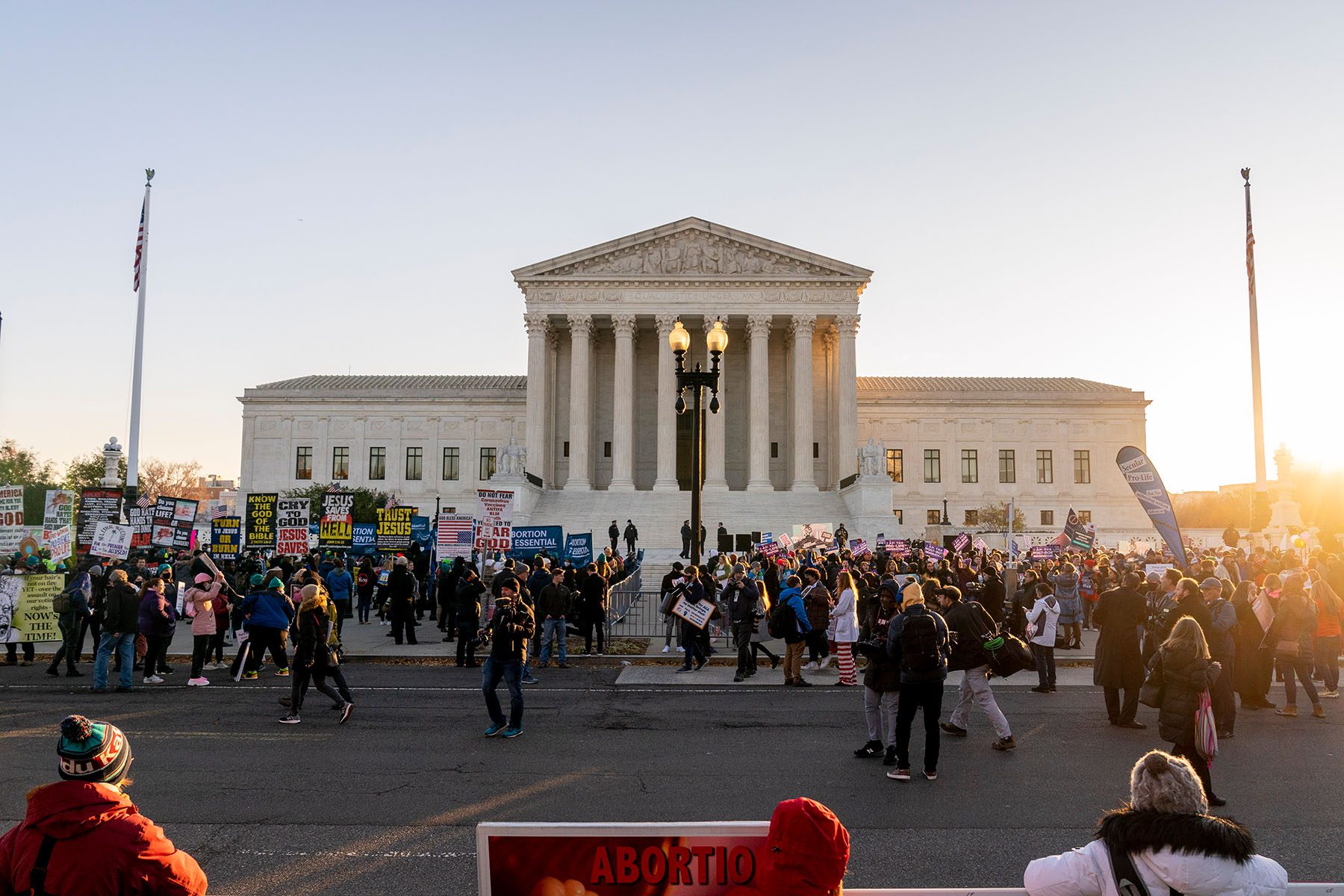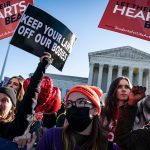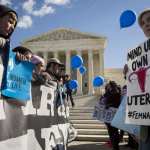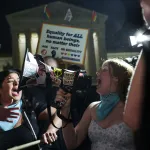Candice Norwood contributed reporting to this piece.
In what may be the biggest challenge to abortion rights since 1973, the Supreme Court appeared starkly divided on whether to uphold the protections guaranteed by Roe v. Wade, the landmark ruling that enshrined the right to an abortion.
But during oral arguments Wednesday, a majority of justices seemed likely to emerge in favor of either fully overturning the 1973 case or at the very least eliminating one of its core protections: the holding that the Constitution guarantees the right to an abortion up until a fetus can live independently outside the womb. This stage, known as “fetal viability,” typically occurs around 24 weeks of pregnancy.
“Prior to today’s argument, I would have hypothesized that we might see [Roe v. Wade] incrementally gutted and possibly gone by 2023 or 2024,” Katherine Kraschel, a lecturer at Yale Law School and expert on reproductive health policy. “But after today’s argument I am more convinced that there are five justices poised to overturn Roe v. Wade.”
Dobbs v. Jackson Women’s Health Organization — one of the highest profile before the court this term — nominally examines a law from Mississippi that would ban almost all abortions after 15 weeks of pregnancy, with no exceptions for cases of rape or incest. But Mississippi used its arguments to suggest that the court should reverse Roe v. Wade in its entirety, letting individual states decide whether to allow abortion or not.
And upholding the state’s 15-week abortion ban would necessarily require eliminating Roe v. Wade’s “viability line” — arguably the core holding of the case, and the standard for which abortion rights are protected in the United States. The viability standard was reaffirmed in 1992’s Planned Parenthood v. Casey, which allowed states to pass laws regulation pre-viability abortions so long as they did not impose an “undue burden” on someone seeking an abortion.
The court’s three liberal justices — Stephen Breyer, Sonia Sotomayor and Elena Kagan — indicated they were skeptical that the Mississippi law should be upheld.
“You come here very honestly, saying, ‘We want you to discard the entire setup,’” Kagan said to Mississippi Solicitor General Scott Stewart. “Usually there has to be a justification — a strong justification — in a case like this, beyond the fact that you think the case is wrong. What strikes me when I look at this case, is that not much has changed since Roe and Casey.”
But the court’s other six justices indicated openness to a decision that would weaken Roe v. Wade but not overturn it entirely. That could either mean allowing states to ban abortions after 15 weeks — a possibility floated by Chief Justice John Roberts — or allowing individual states to determine on their own what abortion restrictions are permissible, as long as they did not violate the undue burden standard.
In front of the Supreme Court building, the weight of that decision was illustrated by a crowd of hundreds on both sides of the debate, separated by pedestrian barricades. Shannon Brewer, the clinic director of Jackson Women’s Health Organization, was visibly tired as she stood among the crowd. It had been a long road over the last several months, she told The 19th.
“It’s a weird feeling because we’ve been working up to this day. There’s been so much going on that it’s almost surreal to finally be here,” Brewer said. “It’s just been a lot in a short amount of time.”
Her clinic, which is at the center of the Mississippi case, is the last abortion clinic in the state. It has seen an explosion of patients, especially after Texas enacted a six-week abortion ban in September. After all of the work and anticipation ahead of the oral arguments, “now everything just stops. Now it’s a waiting game,” Brewer said.
“This is a court with six people who are prepared to overrule and retract in the first time in the history of this country a right that was extended 50 years ago. We’ve never done that before,” said Melissa Murray, a professor and reproductive law expert at New York University.
“There’s not much you can do when you have six conservatives who seem hellbent on dismantling abortion rights whether in total or more piecemeal but still substantive,” she added. “What surprised me was the incredible lengths [Justice Brett] Kavanaugh went to in making the framing that overturning Roe would be a modest reversion.”
A decision in the case is not expected until the end of the court’s term, in or near the summer of 2022.
Research has shown that being denied an abortion is linked to higher rates of poverty, unemployment, bankruptcy and eviction. During oral arguments, Justice Amy Coney Barrett, whose legal scholarship has long suggested a willingness to revisit Roe v. Wade, pointed to laws that allow people to terminate parental rights, and suggested that unintended pregnancy is no longer a great barrier for people — particularly for women seeking economic opportunity — because they can turn to adoption services instead.
“Both Roe and Casey emphasize the burdens of parenting, and insofar as you and many of your [supporting briefs] focus on the ways in which forced parenting — forced motherhood — would hinder women’s access to the workplace and to equal opportunities,” Barrett said.
“However, it doesn’t seem to me to follow that pregnancy, and parenthood are all part of the same burden,” she added.
Julie Rikelman, a lawyer for Jackson Women’s Health, noted that adoption resources existed before Roe v. Wade was decided as well, and argued that both the physical state of unintended pregnancy and the consequence of unplanned parenthood can be detrimental.
Black, American Indian, and Alaska Native people are two to three times more likely to die from pregnancy-related causes than White people in the United States, according to the Centers for Disease Control and Prevention.
“When we hear folks take in coded language about communities that are most marginalized I think, ‘just say who it is.’ This is Black folks, and indigenous folks and people of color who are experiencing this sort of oppression,” said Oriaku Njoku, co-founder and co-director for the Atlanta-based abortion fund provider Access Reproductive Care Southeast, outside of the Supreme Court.
Kavanaugh, who has this term been considered one of the court’s swing votes, indicated openness to overturning Roe v. Wade entirely and allowing individual states to ban abortion.
“Why should this court be the arbiter rather than Congress, the state legislatures, the state supreme courts? The people being able to resolve this,” he said. “There’ll be different answers in Mississippi and New York, different answers in Alabama and California, because they’re two different interests at stake and the people in those states might value those interests somewhat differently.”
According to the Kaiser Family Foundation, 18 states have laws on the books that would prohibit abortions if Roe v. Wade was to be undone. And an analysis by the Guttmacher Institute, which tracks reproductive health policy, suggests that people seeking abortions from those states would have to travel hundreds of miles for care — overwhelming the networks of abortion clinics in states like California, Illinois and Kansas.
Even if the court does not overturn the 1973 case, a decision upholding the Mississippi law would give states a legal framework to restrict abortion access far more than they currently do. That could mean allowing bans at 15 weeks — currently considered unconstitutional — or earlier to take effect.
Many legal analysts also believe such a ruling would encourage states to pass laws that banning abortion earlier and earlier in pregnancy, as a sort of test to see how early the court may let them go.
Kagan suggested such a system would be unworkable.
“’I’m just thinking about the great variety of different regulations that states could pass — whether one is 15 weeks, one is 12 weeks and one is 9 weeks or a variation,” Kagan said. “How would you counsel us to deal with that, if the court were to go down that road?”
The court’s justices were also split on what the implications of such a ruling would mean for other major court-protected rights that are not explicitly mentioned in the Constitution, but that are predicated on similar interpretations as Roe v. Wade. Those include the right to LGBTQ+ marriage, for instance, the constitutional protection for sexual intercourse between people of the same sex, or the right to use contraception.
President Joe Biden, who campaigned vowing to get federal legislation passed that would enshrine Roe v. Wade’s protections, told reporters that he had “not seen any of the debate today, any of the presentation today.”
“I support Roe v. Wade. I think it’s the rational position to take,” he added.
The ability to have an abortion or not can change the course of a person’s life, said Kenya Martin, a 46-year-old Richmond, Virginia, resident who joined demonstrators outside of the court. She was 19 years old and a sophomore in college when she had her first abortion. When she became pregnant again at age 25, family pressure weighed into her decision to give birth to her daughter.
Martin recalled wrestling with the regret and anger she felt about involuntarily becoming a mother. Martin later had other abortions. She said “having the option to parent on my terms was everything to me.”
“It saved my life. I know that we would have been in a perpetual life of struggle had I not been able to access those abortions. And I know that’s probably happening to a lot of people,” Martin said. Her daughter is now 21 years old and she said they have open communication about her experiences.






